For as long as I can recall, Standard has been a format that boasted a solid hierarchy of decks. At the top of the food chain you have your tier one decks. These are the format-defining powerhouses – the Caw-Blades, Faeries, or Junds of their respective eras – as well as the all-around good decks that show they are capable of winning tournaments time and time again. Decks like Mono-Black Devotion make up the current Standard tier one. While Mono-Black might not reach the level of fame and infamy that Caw-Blade or Faeries did, there’s no denying that the deck has been the singular dominant force in Standard since last fall.
Below that are a smattering of other decks that can win any given tournament but which aren’t completely dominating the format. The power of these decks is not something static, but rather drastically shifts in context depending on how the metagame is shaping up. Right now, that looks like Mono-Blue Devotion, Esper Control, Monsters, and Mono-Black relatives like B/W Midrange. Those decks solidly make up the tier two, or tier 1.5, or whatever other arbitrary value system falls below tier one.
Below even that come a number of other strategies. Some of these strategies simply aren’t strong enough to ever become tier one decks because they lack the raw power, consistency, or card pool to be good enough. However, a number of other strategies certainly have what it takes to be a strong deck, but haven’t broken into the metagame for one reason or another. Perhaps they are simply one card short of being dominant, or perhaps all the cards exist and nobody is putting enough effort into making the deck good enough to win.
I often wonder things like: “If Brad Nelson, Todd Anderson, and myself had not all Top 8’d Grand Prix Louisville with the same Mono-Black Devotion list, what would Standard look like now?” Would Mono-Black be as dominant? What direction would the metagame have swung instead? What if nobody had discovered Caw-Blade?
While Mono-Black Devotion is the cream of the crop right now, is there a creamier crop out there? Is there an even better, undiscovered, archetype waiting at the wings? Do formats truly get solved, or is there always something better lurking out there?
To be honest, I don’t know the answer myself. I suspect that there is truth to both sides. I suspect that sometimes the best decks truly are simply the best decks that can be built from those card pools. Other times I suspect that nobody really found it, that there is still a better deck out there that never ended up making it because nobody put those cards together in the right combination. Maybe everyone was content to play Delver. Maybe nobody bothered to find anything else.
When Mono-Black Devotion Top 8’d Pro Tour Theros, it was a rogue strategy. When Brad, Todd, and I played it in Louisville, it was fringe. One week later, it was tier one.
Every dominating strategy has to start somewhere. What’s to say that the current fringe strategies of right now can’t become a dominating strategy in their own right? Junk Reanimator last year was a fringe strategy for a long time. During a period of time when no new sets came out, it quickly escalated from being a fringe deck to the best deck in the format.
Whenever a new set comes out, I think it’s generally a good idea to reevaluate some of the fringe strategies and see if perhaps they finally got the tools they need to bust into the metagame. Was the fringe deck missing one piece that came in the new set? Did a powerful strategy finally find some consistency to pull the deck together? If all that is done when a new set comes out is build new decks and update existing metagame decks, then these fringe strategies can easily fall through the cracks. Who knows what tournament monsters have been lost… never built… never discovered?
For that reason, I’ve picked three fringe archetypes, archetypes that I have spent time playing with and working on in the past, archetypes that I understand, and looked at how they might evolve with Journey into Nyx. This is by no means an exhaustive list. There are infinitely more fringe decks out there, far more than I could ever tackle. However, these are decks that I enjoy playing and decks that I’ve tried hard to make work. These are decks I care about making good, and I feel strongly that I am more likely to experience success in testing, tuning, and updating an archetype when I actually care about its success.
They say you should always save the best for last, but I used to eat ice cream for breakfast, so I think you know how I stand on that issue. I’m gonna start with my baby, and we’ll go from there. Sound good?
Junk Reanimator
From fringe to freak was Junk Reanimator’s 2013 story. Let’s just say I’m looking for an encore. Perhaps we can bring the band back from the dead for a second go at it?
Coming into Journey into Nyx, this was my deck of choice. Was it dominating? You might say, “no”. Personally, I preferred to say, “not yet”. I felt like the deck had what it took to get to that mystical place known as “there”, and with proper testing and tuning could hang with the big dogs.
This was my most recent list:
Creatures (25)
- 2 Obzedat, Ghost Council
- 3 Sylvan Primordial
- 4 Elvish Mystic
- 2 Shadowborn Demon
- 2 Polukranos, World Eater
- 4 Sylvan Caryatid
- 4 Courser of Kruphix
- 4 Satyr Wayfinder
Planeswalkers (3)
Lands (22)
Spells (10)

The deck had a lot of great things going for it, but it still had some holes. There were basically three main problems with the current list in the metagame. Fortunately, Journey into Nyx provides some great solutions to all three of those problems, which can only help this archetype out greatly moving forward.
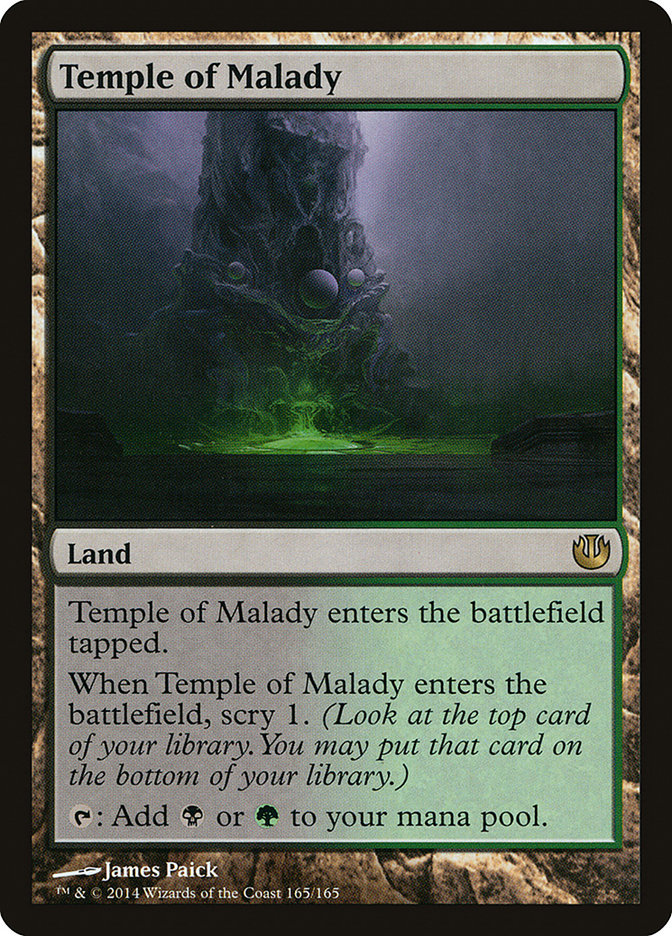
This is one of the big additions. It may seem like an odd connection to draw, but Temple of Malady is one of the best solutions for the worst problem the deck had: Pack Rat.
I found Mono-Black Devotion or variants thereof to be generally great matchups. That is, except for Pack Rat. A turn-two Pack Rat was near impossible to handle. Pack Rat was public enemy number one. Reanimator was too slow to really match pace with Pack Rat, and the late-game threats like Sylvan Primordial, Shadowborn Demon, and Obzedat were not equipped to adequately race or contain Pack Rat. The game frequently devolved into a subgame where you had to find an Elspeth to fight Pack Rat or you just lost. Then you just had to cross your fingers that they didn’t have Bile Blight, or enough copies of Hero’s Downfall to match the number of available Elspeths you had.
The card Bile Blight exists in the sideboard entirely to deal with Pack Rat and for no other reason, although as a side benefit it is actually great against a variety of other decks in the field as well. The main limiting factor for Bile Blight (and the sideboard Hero’s Downfall as well) is that finding two black mana early enough in the game can sometimes be problematic.
How does Temple of Malady solve Pack Rat? Well, Temple of Malady means that, if you so desire, you can play eight black-producing Temples, making it much easier to curve a Temple into a Swamp or Overgrown Tomb to fire off a Bile Blight as early as turn two. Temple of Malady really was the missing piece for the manabase, and having access to this card could really improve the issues the deck was having in having early enough black mana and yet still having enough white sources to cast Elspeth and Obzedat later in the game.
Temple of Malady could also mean that the deck can get away with fewer shocklands, which can also help improve the matchups against hyper-aggressive decks. Playing so many shocklands and having a deck that is slow to accelerate out of the gates meant that no matter how many great cards the deck had against aggressive decks, such as Courser, Polukranos, and Whip of Obzedat, you were still at the mercy of their draw because you might still be too slow in deploying those cards. By cutting down on the damage you can deal to yourself, you buy yourself often a turn or more of time. That matters.
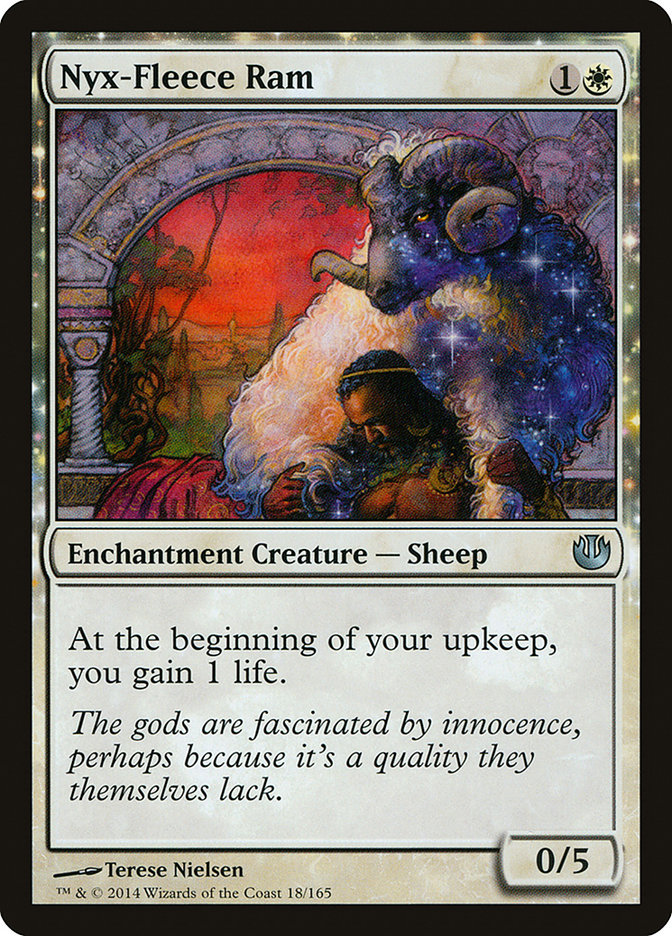
Another great tool for solving our hyper-aggressive decks problem is this innocent-looking creature from Journey into Nyx. I actually think this card is very good and likely one of the most under-hyped cards from the set. It is very difficult to swing past this creature, it dodges nearly all removal from aggressive decks, and gaining one life a turn is no joke. I feel as though having access to this in the sideboard will really boost Reanimator’s win percentage against decks like Mono-Red significantly.
Nyx-Fleece Ram also pairs very well with Archangel of Thune. I think with access to cards like Courser, Ram, and Obzedat that provide a slow but steady trickle of lifegain that will all separately trigger Archangel of Thune numerous times over the game, it is time to finally make room for Archangel in the deck.
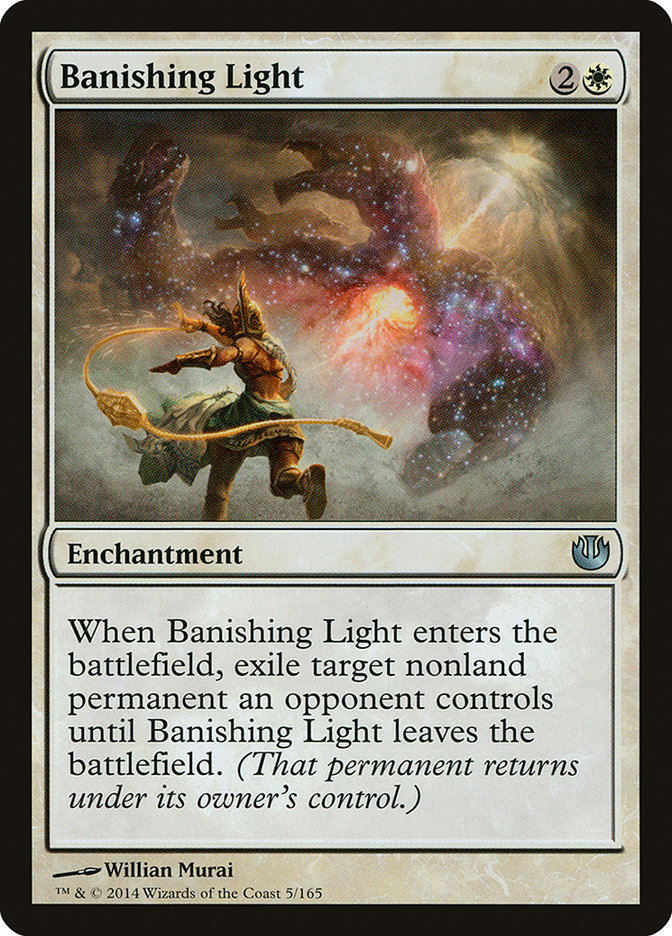
I guess I lied. Sometimes you do save the best for last. Banishing Light, the new Oblivion Ring variant, is the most exciting card for this deck from the new set. Problem three for Reanimator was Jace, Architect of Thought.
Creatures like Courser of Kruphix, Satyr Wayfinder, Elvish Mystic, and all of Elspeth’s soldiers all got bricked or significantly neutered by Jace’s +1 ability. Against a deck like Esper Control, it was very difficult to actually pressure Jace and far too often it was impossible to deal with one before they just ticked it straight up to 8 and ultimated it.
While a card like Sylvan Primordial was perfect for killing Jace, the issue is that if you burned all of your cards like Sylvan Primordial on Jace, then you stood to just lose to something like Elspeth afterward. It was so much better for you if you could just deal with Jace easily and then have Sylvan Primordial around to blow up Detention Spheres and Elspeths, which was far more devastating.
Vraska and Hero’s Downfall were both in the sideboard entirely to deal with Jace, Architect of Thought. While both cards also shined elsewhere, Banishing Light is finally a cheap and easy answer to Jace. The kicker? Unlike Hero’s Downfall, you can Obzedat’s Aid it back into play.
Banishing Light also provides an excellent answer to occasionally problematic permanents like Master of Waves, Thassa, and Domri Rade. Banishing Light can also sometimes take care of a Pack Rat if you are on the play or have an Elvish Mystic and untapped white source on the draw.
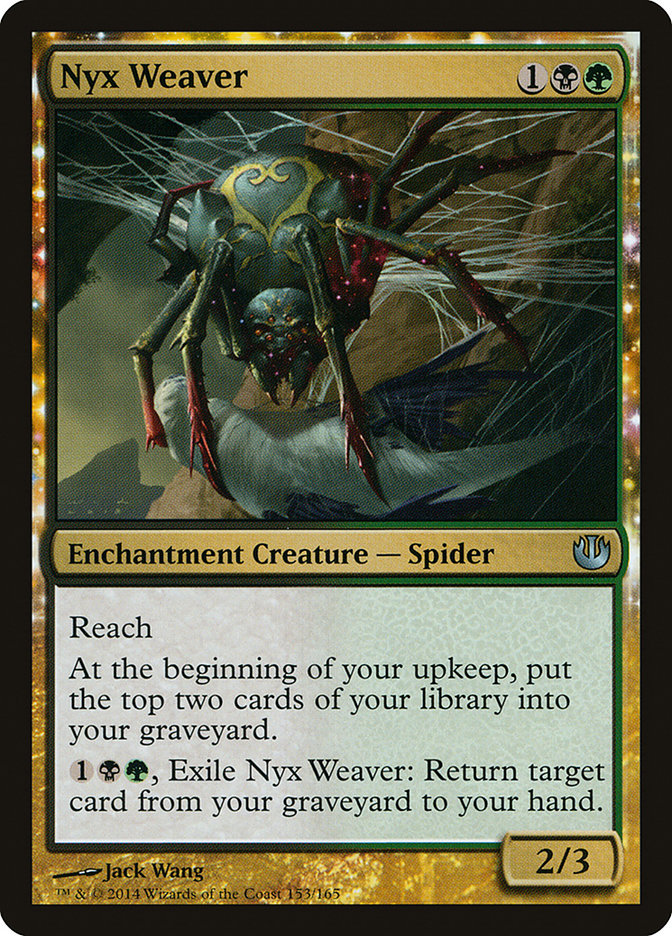
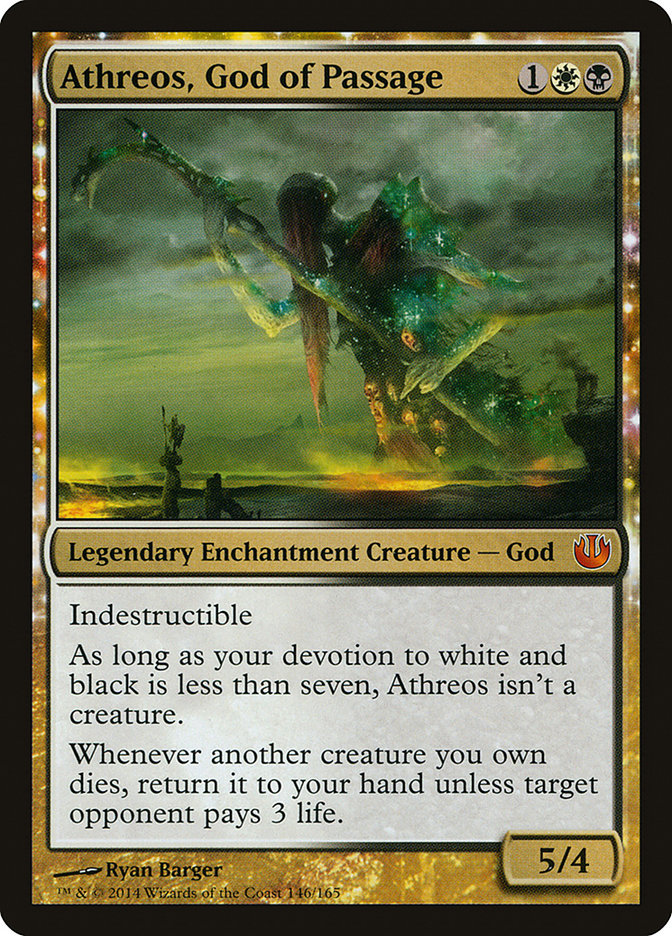
I don’t feel like either of these cards are good enough to make the cut. Athreos doesn’t really synergize with the deck very well (the deck doesn’t care about creatures ending up in the graveyard), and it’s hard to turn it into a creature when every creature that costs less than five provides zero devotion to Athreos.
Nyx Weaver is just too slow to be effective, in my opinion. Unlike the G/B deck, this deck doesn’t really benefit nearly as much from just having stuff in the graveyard. The G/B Dredge deck has Shadowborn Demon, Jarad, Nighthowler, and Nemesis of Mortals that all benefit solely from having a bunch of creatures in your graveyard. Nyx Weaver could be a great fit in that deck, but it is just way too slow to be effective here. The ability to dump cards doesn’t often matter, and you have to invest between 11-13 mana to get back into play any effective threat from it.
Keep in mind that Reanimator generally plays like a midrange deck that has a powerful Plan B of reanimating creatures. The Reanimation “Plan B” gives the deck great lasting power, but it’s not essential to victory. One of the biggest mistakes people typically make is to play the deck like you have to reanimate things to win. I side out Obzedat’s Aid and Whip in a lot of matchups. This deck isn’t a Reanimator deck, it’s a good deck that can reanimate things, and I wouldn’t play cards that solely fuel the graveyard unless they also provided other tangible benefits. Just like Splinterfright was never played in old Junk Reanimator, I don’t think Nyx Weaver gets played here.
Ultimately, when you put it all together I am looking at a list that looks something like this:
Creatures (22)
- 2 Obzedat, Ghost Council
- 3 Sylvan Primordial
- 4 Elvish Mystic
- 2 Archangel of Thune
- 4 Sylvan Caryatid
- 3 Courser of Kruphix
- 4 Satyr Wayfinder
Planeswalkers (3)
Lands (22)
Spells (13)

It is possible that without Shadowborn Demon in the maindeck Whip should be cut down to just one copy, and it is also possible that with Banishing Light in the deck our Grisly Salvages becomes significantly worse since there are now considerably fewer powerful targets for the card to nab. Ultimately, that will come down to testing. All I can say is that there are a lot of good new cards for this deck and I am excited to get to working on it.
Sunny Delight
Sunny Delight, or white-based devotion strategies, have long been a strategy I have tried to make work in my quest to give Heliod his due as rightful king of Theros. Unfortunately, they have all basically suffered from the same basic problems: issues beating Sphinx’s Revelation decks and the urgent need to have non-creature sources of Devotion to power Nykthos and Heliod.
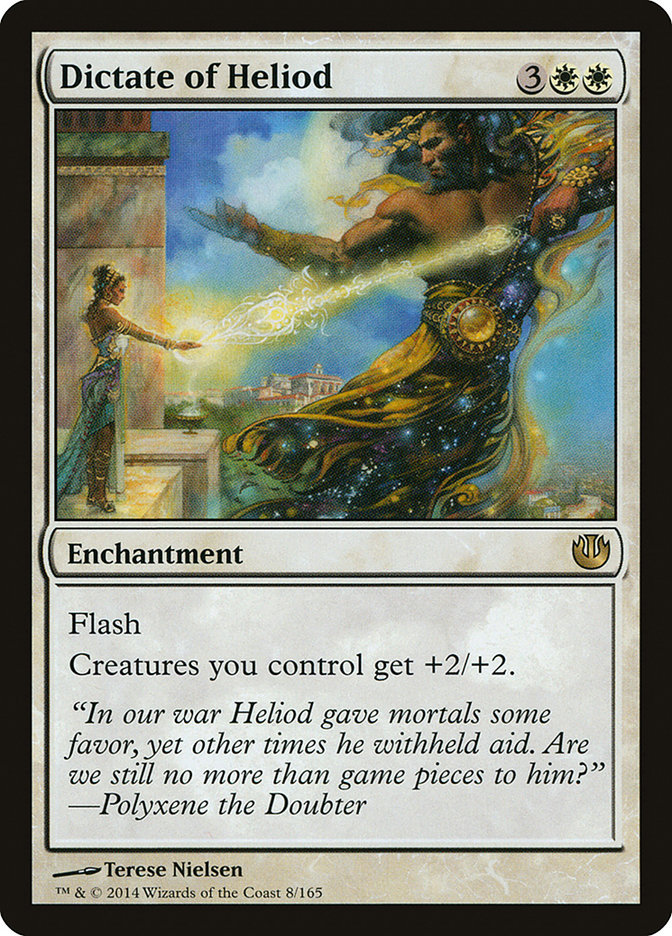
One of the core elements of the white devotion strategy is to flood the board with tokens. Cards like Precinct Captain and Brimaz provide a few tokens to complement Elspeth, Sun’s Champion and Heliod, God of the Sun, who are our heavy token hitters. Spear of Heliod has long been an all-star in the strategy for turning those tokens into something meaningful. However, with Spear being legendary it was never viable to run more than a few copies, and additional copies of Spear could never provide more devotion to Heliod.
White Devotion also had huge issues with cards like Supreme Verdict and Jace, Architect of Thought. Without many non-creature sources of devotion, it couldn’t help but overextend into a Supreme Verdict, and without drawing one of the few precious copies of Spear of Heliod those tokens struggled to battle past an active Jace.
Dictate of Heliod, as someone suggested in the comments of a recent video of mine, is a great fit for the deck. It both solves the Jace problem and provides powerful non-creature Devotion for Heliod at the same time. Also, a single Dictate turns Heliod’s Clerics into powerful 4/3’s with Vigilance, and Elspeth’s soldiers into 3/3’s with Vigilance. That is a big board presence.
The last awesome aspect is that it can be a huge blowout in combat due to flash, and it can also be a huge blowout by turning Heliod into a creature at instant speed on defense if need be. I doubt your opponents will play around a flashed-in Dictate of Heliod, at least not at first!
Hall of Triumph, while also suffering from being Legendary, could also serve as another way to boost white creatures, providing the deck with a plethora of anthem effects.

Banishing Light provides another answer to issues like Jace and Elspeth without requiring dipping into blue for Detention Sphere. This opens the door for white devotion to end up splashing colors like red or black instead. Also, it makes it possible to just opt for Banishing Light over Detention Sphere, which then also gives access to a card like Renounce the Guilds to see play.
Banishing Light is also an awesome answer to Thassa, God of the Sea, who has historically also been very problematic for this deck. Sunny D is all about outclassing and out-brawling other creature decks in the combat step, either by pump effects like Spear of Heliod or by the sheer numbers provided by Heliod and Elspeth. Thassa is a huge hole in that plan, as making creatures unblockable easily slips around the deck’s defenses.
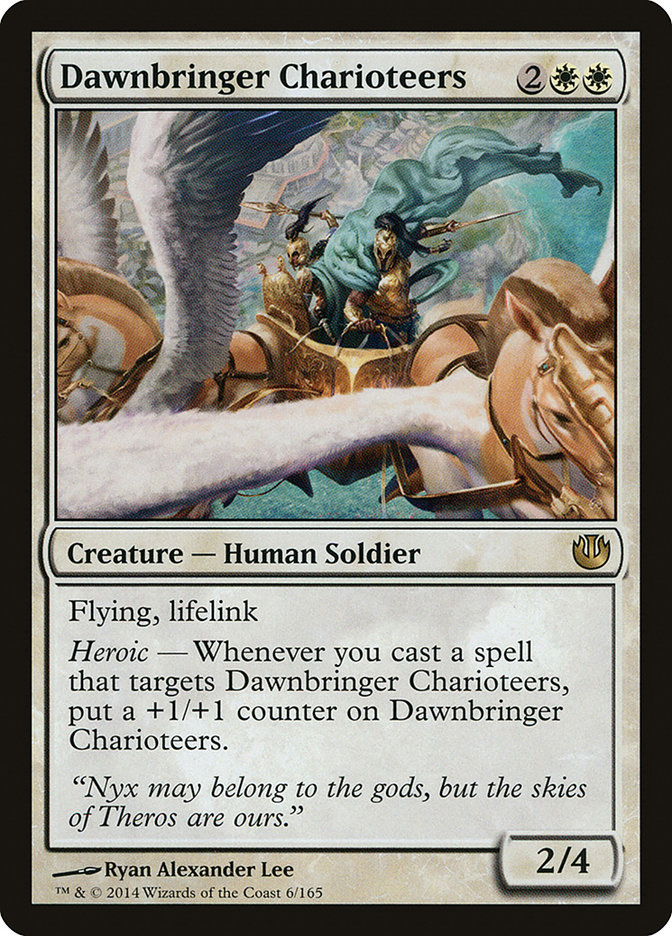
While the deck cannot really trigger the Heroic ability, I still think this creature could provide to be a huge advantage against other creature strategies by virtue of simply being a 2/4 flying lifelinker. That body is already enough to really be a huge brick wall against Mono-Blue, especially with Banishing Light to deal with Thassa. Alongside cards like Dictate of Heliod and Spear of Heliod, Dawnbringer Charioteers could easily become a huge monster in the air.
Dawnbringer Charioteers also plays very nicely with Archangel of Thune in your deck, and the one-two punch of Dawnbringer Charioteers into Archangel not only boosts devotion significantly but also provides an enormous board presence.
When it is all said and done, I still feel like splashing blue for Sphinx’s Revelation and anti-control sideboard options is the best direction to take Sunny D, but the presence of these cards definitely does open the door for W/r or W/b to be able to reasonably compete in the same arena.
Creatures (15)
- 4 Precinct Captain
- 2 Heliod, God of the Sun
- 4 Soldier of the Pantheon
- 1 Ephara, God of the Polis
- 4 Brimaz, King of Oreskos
Planeswalkers (4)
Lands (27)
Spells (14)

“Esper” “Humans”
Both Esper and Humans are in quotation marks, and separately in quotation marks, because I don’t believe the deck I am speaking of needs to be Esper anymore – nor are the bulk of creatures Human at this point. I still want to call the deck Esper Humans for minimum value, though.
Here’s an example of what a list looked like prior to Journey into Nyx:
Creatures (23)
- 2 Pack Rat
- 3 Lyev Skyknight
- 4 Precinct Captain
- 3 Obzedat, Ghost Council
- 4 Soldier of the Pantheon
- 2 Ephara, God of the Polis
- 3 Brimaz, King of Oreskos
- 2 Herald of Torment
Lands (25)
Spells (12)

I think this deck is one of the decks that stands to gain the most from Journey into Nyx, and one of the big reasons is the card that tickles my inner Orzhov fanboy.

As an aside, I think this is going to be the best Athreos deck. I have been asked numerous times what I think of Cartel Aristocrat and Xathrid Necromancer, both on social media and multiple times in the comments when I played an earlier shell of this deck in a versus video last week.
Frankly, I don’t think Cartel Aristocrat and Xathrid Necromancer are good enough. I just don’t think there are enough supporting pieces to make them good. Just because they have synergy with each other and synergy with Athreos doesn’t mean that you have to play them with Athreos. Lots of cards have synergy with each other but they are just too slow, unwieldy, or ineffective for that synergy to actually matter at all.
Cartel Aristocrat and Xathrid Necromancer are embarrassing creatures on their own, and without some super-powerful synergies like Blood Artist and Lingering Souls to really fuel them, I just don’t think there is enough there. You might be able to live the dream of looping Xathrid Necromancer with a Cartel Aristocrat and Athreos in play, but you still can’t attack through a Courser of Kruphix, a Master of Waves or a Gray Merchant of Asphodel.
I’d rather play more individually powerful cards like Pack Rat and Herald of Torment, cards that are good when you don’t draw the other synergy-laden cards, and stick to trying to beat my opponent with a bunch of good cards – of which Athreos is one.
I like Athreos in this deck for a few reasons. First of all, sometimes the deck just gets explosive draws with Soldier of the Pantheon, Precinct Captain, Brimaz, and Spear of Heliod. Athreos is a great closer in games like that.
Secondly, it is very easy to turn devotion for Athreos on, especially since Obzedat himself provides 80% of the devotion you need. One other symbol from any other permanent along with Obzedat will turn Athreos into a creature. Whip and Spear both provide permanent sources of “Doom Blade-proof devotion” as I like to call it – devotion that you’re not going to lose when your opponent’s opening hand has three lands and four removal spells.
Lastly, Athreos is likely just miles better than Ephara was in this deck. Ephara did not impress me when I battled with it, and I feel like Athreos could easily be a stronger substitute. Why is this important? It means that without Ephara, it is likely possible to just cut out the blue entirely and focus on straight W/B. That provides better and less-painful mana, and in turn allows you to play powerful heavier black cards like Bile Blight and Herald of Torment that are otherwise a stretch to play in the Esper version for mana reasons.

Would you look at that! It’s another deck that benefits from the new Oblivion Ring. When I decided to write this article, it didn’t even cross my mind that the three decks I was planning on investigating were all decks that want Banishing Light, but it doesn’t really surprise me very much. Elspeth, Sun’s Champion is one of my favorite cards in Standard, I like grindy white decks, and Banishing Light is potentially the single most impactful card from Journey into Nyx in relation to the rest of the cards already in the metagame.
The main value that Banishing Light provides in this deck is that it completely invalidates the need for Detention Sphere. With Athreos kicking Ephara out and Banishing Light replacing Detention Sphere, the blue cards can just go. Lyev Skyknight, I love you like a brother (who was separated at birth and who I have never met), but you’re not good enough by yourself to cling onto eight additional shocklands and a much-worse manabase. Sorry, buddy.
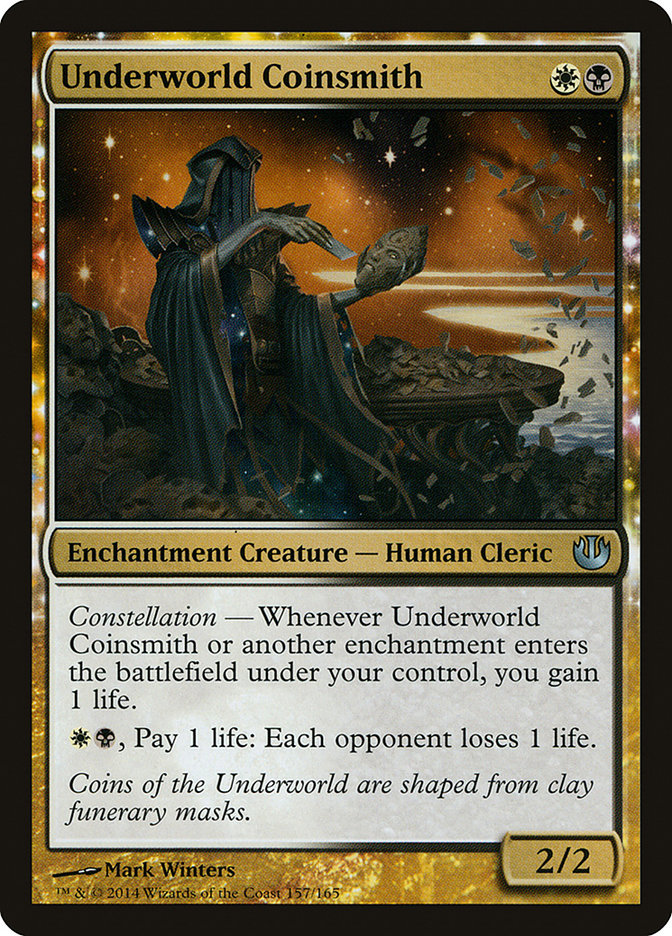
This seemingly-innocuous card is likely exactly that, innocuous. There is a very high chance that this card ends up doing nothing in Standard. However, I can’t just throw away the card for good: part of me thinks that there might actually be a little more here than meets the eye. His abilities, for one, synergize well with Athreos. The incidental life loss pushes Athreos’s triggered ability more and he gains you a life when Athreos enters play.
Underworld Coinsmith feels like a card that could be good against both ends of the spectrum. Against hyper-aggressive decks, he gains you a life and trades. Against control decks, he plays a similar role to a card like Deathrite Shaman, it doesn’t have to attack to be a threat. I feel where he is weakest is against decks in the middle, like G/R Monsters, that don’t care about either ability. If the metagame polarizes toward both extreme ends of the spectrum instead of hanging around in the middle zones, Coinsmith could end up being less Coinsmith and more Coinsmith and Wesson.
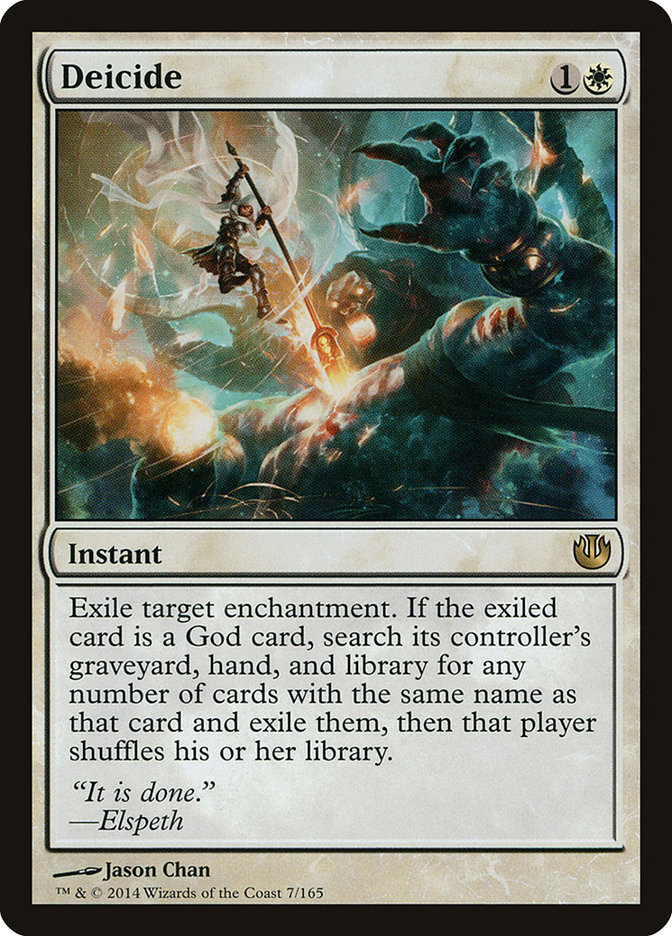
Thassa is the ultimate beating against decks like this. If I’m playing a deck like this in a tournament and my opponent leads on Cloudfin Raptor, I sometimes just go ahead and sign the slip right there. It is extremely hard to beat Thassa with a deck that isn’t fast enough to race and isn’t big enough to go over top. Banishing Light helps a lot, but Deicide also provides a huge edge in post-board games where you can remove Thassa once and for all and focus on playing a real, fair game, where your creatures will actually outclass theirs.
Creatures (23)
- 2 Pack Rat
- 4 Precinct Captain
- 3 Obzedat, Ghost Council
- 4 Soldier of the Pantheon
- 3 Brimaz, King of Oreskos
- 4 Herald of Torment
- 2 Athreos, God of Passage
- 1 Underworld Coinsmith
Lands (25)
Spells (12)
Sideboard

One thing I didn’t mention but which I feel is important is that I think Herald of Torment is actually insanely good and going to be a big part of Standard moving forward, and this deck is a great shell to take advantage of Herald. Brimaz and Precinct Captain are both great Bestow targets for Herald by virtue of providing blockers on the back end and having Vigilance.
There’s really no way to know for sure whether any of these fringe decks are going to have what it takes to cut it in Standard moving forward despite gaining a lot from Journey into Nyx. However, at the very least one thing is clear: there’s no way to know if we don’t try. There are so many powerful cards in this Standard format that I refuse to believe there aren’t any decks that can exist to throw Mono-Black Devotion from its current reign atop the Standard format. I don’t know if I can find the solution, but I don’t intend on leaving any rocks unturned along the way.
Unless they are Rock Lobsters. Nothing beats the surprise of turning one of those over…’cept Paper Tiger.
